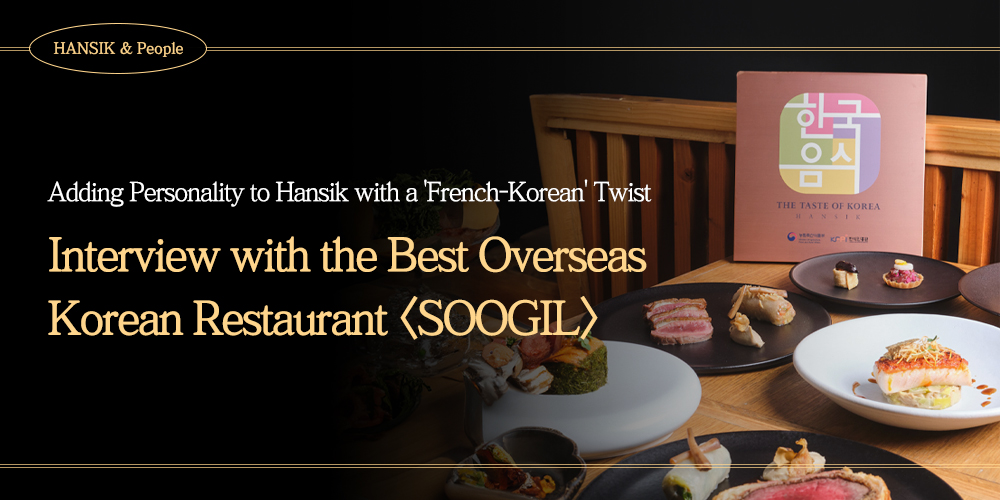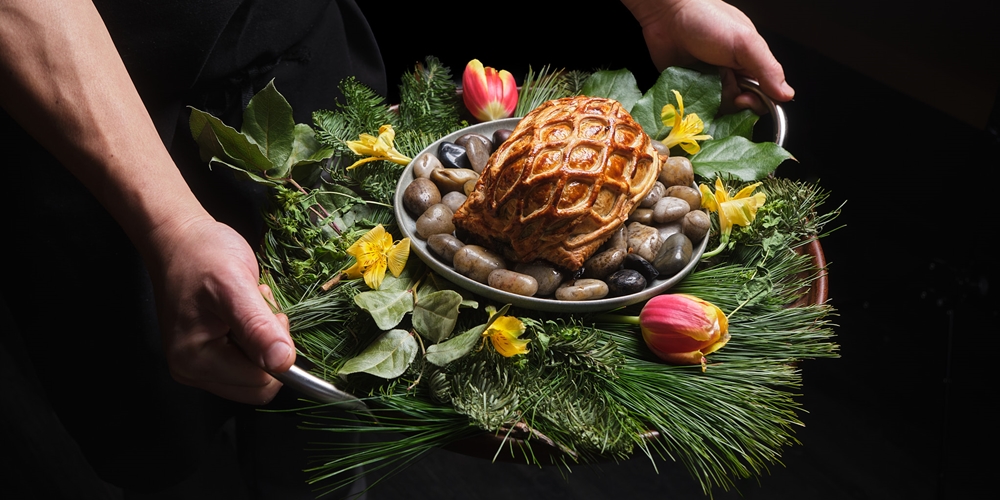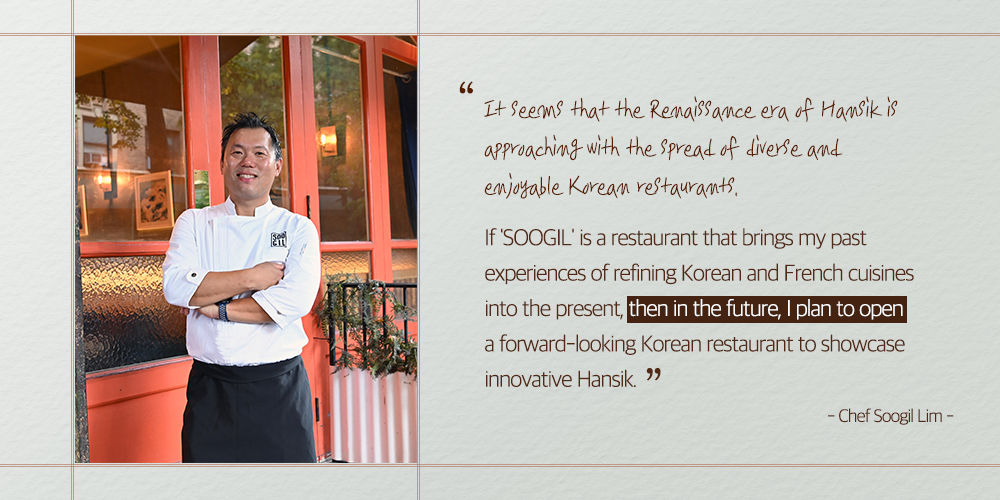한식 읽기 좋은 날
Interview with 'COTE', the Best Overseas Korean Restaurant
HANSIK & People

The unique variations of familiar ingredients add pleasure to the food. 'SOOGIL,' which presents distinctive Hansik with a blend of French techniques, is a fine-dining restaurant that properly showcases this delicacy.
Located in Manhattan, New York, SOOGIL offers a unique cuisine concept called 'French-Korean' under the command of Chef Soogil Lim. Combining Western sensibilities with Korean flavors, SOOGIL has received high acclaim locally, and has also been designated as a ‘Best Overseas Korean Restaurant' by the Ministry of Agriculture, Food and Rural Affairs and the Korean Food Promotion Institute.
We met with Chef Soogil Lim, who hopes that dining at SOOGIL will go beyond a nice meal to an experience full of joy and happiness.

A French-Korean restaurant infused with life
As the saying goes, "You can tell a lot about a person by looking at their desk," similarly, when you look into a restaurant, you can see the chef's life, and 'SOOGIL' thoroughly encapsulates Chef Lim’s culinary journey. Rising to the position of sous chef at 'Daniel,' one of New York's top French restaurants, Chef Lim, its first Korean chef, then furthered his culinary career as the head chef at the Korean restaurant 'Hanjan.' It seems natural that 'SOOGIL,' named after Chef Lim himself, became a restaurant exploring the intersection of Korean and French cuisines, given his background and expertise in both culinary worlds.
"After working for seven years at the upscale restaurant 'Daniel,' where more than 200 people visit daily, I acquired French culinary skills, and during my four-year tenure at 'Hanjan,' I not only created various Korean dishes but also gained indirect experience in restaurant operations. 'SOOGIL' is a restaurant that brings forth these past experiences into the present."

At SOOGIL, only two tasting menus are offered: a four-course prix fix and a six-course chef’s tasting menu.
There's a special story behind the introduction of the tasting menus, which is considered a symbol of fine dining. Chef Lim recollected, "During the pandemic, I wanted to offer a special experience to guests who ventured out of their homes to visit the restaurant." He continued, "After much contemplation, I decided to present my unique tasting menus using premium ingredients beloved by locals while using Korean staples like gochujang (red chili paste), soy sauce, and doenjang (soybean paste) as core ingredients"
Introducing a high-priced tasting menu was a challenge for Chef Lim. Not only was the restaurant located in the East Village where many affordable restaurants catered to the university crowd, but SOOGIL's interior design also differed from the typical premium restaurant. Chef Lim noted, "While studying various cases, I realized that determining the value of the menu wasn’t the flashy interiors but rather the chef's experience and pride in the food." He added, "Creating dishes I wanted through the tasting menus has led to positive feedback from guests."
Chef Lim added, "It's been six years since I opened the restaurant, and I believe the reason behind its success is the fact that we've been able to adapt flexibly to changes."

"Food Inspired by Hansik & Flavored with Hansik”
From nurungji (scorched rice) foie gras, grilled black cod with gochujang (red chili paste), to black truffle doenjang (soybean paste) soup, SOOGIL's innovative dishes draw inspiration from everyday Hansik and transform it into culinary delights.

▲ Kimchi Rolled in Greater Amberjack and Doenjang Soup
The dish "Kimchi Rolled in Greater Amberjack" involves wrapping baekkimchi (white kimchi) and apple in greater amberjack and topping it with caviar, inspired by a restaurant in Gyeongsang-do (Gyeongsang Province) that serves aged kimchi and raw fish together. The “Doenjang Soup” made with doenjang, scallops, potatoes, and truffles, also evokes various ingredients found in traditional doenjangjjigae (soybean paste stew) served on Korean tables.
▲ Nurungji (scorched rice) Foie Gras
Consistently loved since the restaurant's opening, "Nurungji Foie Gras" draws inspiration from dolsotbibimbap (hot stone pot bibimbap). It features nurungji (scorched rice) cooked in a hot iron plate, topped with onions, foie gras, and pear. The finishing touch is the soy sauce, poured by the server at the table, which pays homage to traditional Korean sauces. Chef Lim explained, "Usually, foie gras is eaten with bread, but by combining it with rice and soy sauce instead, we've incorporated Korean elements to the dish."
Chef Lim infuses Korean identity into the sauces that form the foundation of taste. He mentioned, "When designing the course menus, I included soy sauce, doenjang (soybean paste), and gochujang (red chili paste) for each course, which are at the heart of Hansik." Even in SOOGIL's signature dish 'Beef Wellington,' soy sauce and seolleongtang (ox bone soup) based sauce are used. This special sauce is created by first cooking seolleongtang by simmering calf bones for a day and then adding red wine and soy sauce to achive a change in flavor.

▲ SOOGIL's signature dish “Beef Wellington” is made by spreading foie gras and mushroom paste on beef,
wrapping it in dough, and then baking it.
Chef Lim said, "As the dishes don't immediately look like Korean food, I wondered how I could explain the Korean flavors used here." He added, "Not only do we list the menu items in Korean on the menu, but our staff also introduces and explains ingredients like doenjang, gochujang, and ganjang to guests with their original Korean pronunciations."

▲ Grilled black cod with gochujang and sea urchin roe bibimbap made with domestic ingredients
Not limiting itself to traditional sauces, SOOGIL actively utilizes domestic ingredients such as Niitaka pear, kelp, laver, salted pollack roe, and strawberries. Lim emphasizes meticulous attention to detail to ensure that Korean flavors permeate the dishes, whether it's by simmering broth with kelp sent by his mother from Korea or using domestic pears for garnish.
"We've also added a touch of Korean elegance by incorporating Korean ceramics throughout the restaurant, in addition to using domestic ingredients and tableware. It's a small effort to express the essence of a Korean restaurant."

Hansik Captivating the Global Gourmet Industry
After spending a long time in the fine-dining industry in New York, how does Chef Lim perceive the present and future of Hansik?
Chef Lim said, "The number of Korean restaurants receiving Michelin stars has increased to 11, and even The New York Times has covered Korean fine dining in special features. There's a trend towards the upscaling of Hansik." He explained, "Restaurants like SOOGIL, championing modern Hansik, have significantly increased and are spreading diversely, even regionally." He added, "What sets them apart from traditional Korean restaurants in Koreatown is that chefs incorporate their own storytelling to present localized Hansik."
Continuing, Chef Lim expressed his anticipation, saying, "It seems that a Renaissance era of Hansik is emerging throughout Manhattan." He attributed this to the spread of diverse Korean restaurants, ranging from upscale establishments that insist on tasting menus to fun-filled eateries like Korean-style fried chicken joints and gukbap (rice soup) specialty shops. In line with this wave of change, he is preparing to open his second Korean restaurant, 'Raon.'
"Raon" means 'joy' in pure Korean. While SOOGIL combines my past experiences of Korean and French cuisines, Raon is envisioned as a forward-thinking Korean restaurant rooted in tradition but showcasing innovative dishes."

Chef Lim mentioned that he always reflects on the spirit of 'Beopgochangsin' by Master Yeonam Park Jiwon. He sees parallels between this phrase, which means 'learning from the past to create something new,' and the essence of SOOGIL. Just as the phrase implies, SOOGIL blossoms with new dishes based on Hansik. We look forward to seeing what unique culinary delights SOOGIL will bring to fascinate our palates.
Address │ 108 East 4th Street, New York, NY 10003
Hours │ Wednesday-Thursday (5:30PM~10:30PM) / Friday-Sunday (5:00PM~11:00PM) / Closed on Mondays and Tuesdays

 한국어
한국어
 English
English






